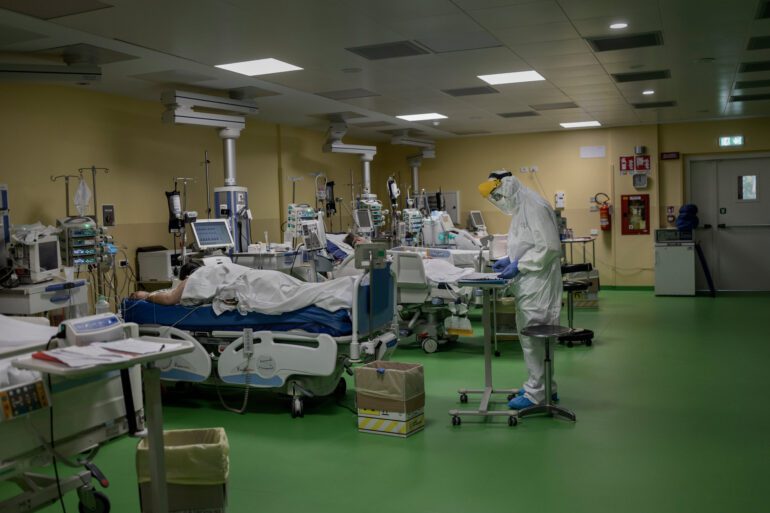TL;DR:
- The COVID-19 pandemic exposed shortcomings in healthcare systems, with millions of cases and deaths worldwide.
- Hospitals faced ICU capacity issues during outbreaks due to insufficient staff and equipment.
- A deep learning model predicts ICU need by analyzing chest X-ray images.
- “Transfer learning” technique aids model development using existing expertise.
- The model achieved accurate ICU admission predictions within 24-96 hours.
- It matched existing models’ performance, relying solely on X-ray images.
- Researchers plan to improve the model by incorporating broader data and variables.
Main AI News:
The global healthcare landscape faced an unprecedented upheaval with the emergence of the COVID-19 pandemic, unmasking critical vulnerabilities within the systems. As of the latest count in June 2023, the world recorded a staggering 760 million confirmed COVID-19 cases, resulting in nearly 7 million fatalities. The apex of this crisis witnessed hospitals stretched to their limits, grappling with surges in intensive care unit (ICU) demand to administer life-saving invasive mechanical ventilation for COVID-19-positive patients. An acute scarcity of staff and intubation equipment frequently plagued these overwhelmed ICUs.
A prospective solution to this dire conundrum lies in the precise anticipation of patient prognoses following a COVID-19 diagnosis. Medical practitioners traditionally employ chest X-ray radiography (CXR) scans to evaluate patient health statuses. These images, scrutinized for pneumonia indicators, offer insights into potential ICU admissions. This strategic approach optimizes the allocation of precious hospital resources. Nonetheless, this process exacts a substantial labor toll, time investment and contends with diagnostic variances—predominantly amplified during large-scale outbreaks.
Could Artificial Intelligence (AI) emerge as the catalyst in this realm? A recent Journal of Medical Imaging publication illuminates a groundbreaking study conducted by the University of Chicago’s Department of Radiology. The study introduces a revolutionary deep learning-driven model capable of predicting ICU admission necessity via comprehensive analysis of CXR images.
Central to this novel approach is the incorporation of “transfer learning”—a game-changing technique. Crafting deep learning models tailored for medical imaging applications proves uniquely challenging due to the voluminous annotated data prerequisites for robust training. Instead of laboriously training a model from scratch on myriad images, transfer learning facilitates the transference of knowledge from a pre-established model to a new one. The strategy entails refining the recipient model with dedicated data, capitalizing on the acquired expertise of its predecessor. Imagine a model trained to detect specific diseases in magnetic resonance images, primed to underpin a different model designated for disparate ailment identification.
The researchers adeptly wielded sequential transfer learning to craft their ultimate predictive powerhouse. Commencing with a large model pre-trained on a repository of 1.2 million natural images from ImageNet, they meticulously honed it with CXR images from the National Institutes of Health database to discern a spectrum of 14 distinct diseases. Subsequently, they meticulously fine-tuned this model with data from the Radiological Society of North America, sharpening its proficiency in pneumonia detection. The pinnacle of their effort materialized through finetuning with an in-house dataset—comprising 6,685 CXR images from 3,998 COVID-19 patients.
The resultant AI model exhibited a remarkable aptitude for prognostication. It could accurately predict the requirement for ICU care within 24, 48, 72, and 96 hours post-CXR examination. Impressively, in an independent evaluation of 1,672 CXR images from 1,048 patients, the model achieved an area under the receiver operating characteristic curve of 0.78 for ICU admission prediction at 24 hours and not less than 0.76 for 48 hours or beyond. Notably, patients identified by the model as high risk were nearly five times more likely to necessitate intensive care. Intriguingly, this AI model’s performance stood on par with existing counterparts, despite its exclusive reliance on CXR images sans supplementary clinical data.
In its entirety, this remarkable model bridges a critical chasm in clinical practice. While numerous machine learning models emerged for COVID-19 diagnosis, scarce endeavors addressed the imperative task of prognosis prediction. The proposed AI marvel could fundamentally bolster clinical decision-making and resource management, thereby elevating the caliber of patient care. Evidently, the researchers remain unflinchingly committed to refining their creation. Their future roadmap encompasses multi-institutional CXR image integration, assimilation of pertinent clinical variables, expansion to encompass lung opacities associated with related conditions, as well as the integration of advanced image segmentation and preprocessing maneuvers.
Conclusion:
The emergence of an AI-driven predictive model for ICU admissions in COVID-19 patients marks a significant leap forward in healthcare capabilities. By leveraging deep learning and transfer learning techniques, the model showcases impressive accuracy in forecasting ICU needs based on chest X-ray images. This breakthrough has far-reaching implications for the medical technology market, indicating a shift towards data-driven clinical decision-making and resource optimization. As AI continues to play an increasingly crucial role in healthcare, the model’s success underscores the potential for enhanced patient care and improved operational efficiency in the industry.

